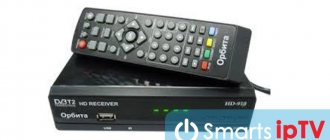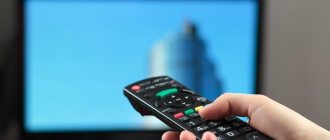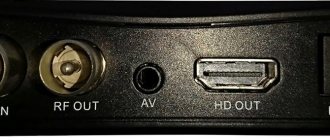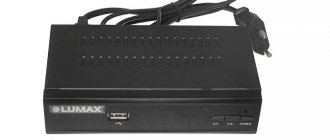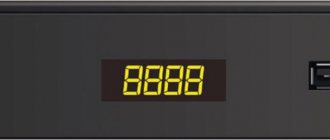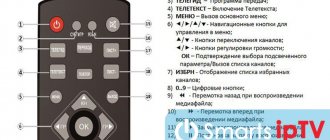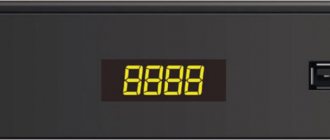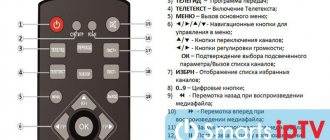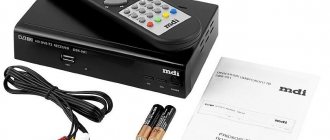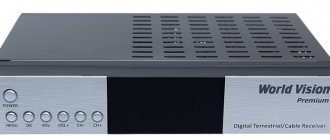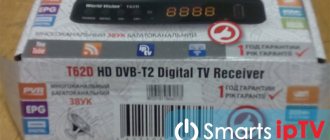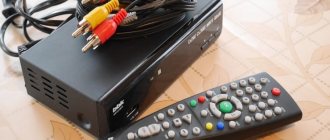“How to connect and configure the Orbita digital set-top box?” is a popular question among TV users, since Russia is moving from analogue to digital television. Connecting the set-top box does not take much time and is not particularly difficult. That is, each user can independently configure the device, without calling a specialist. Find out how to do this in this article.
Characteristics of Orbita digital set-top box models
All Orbit models on the market do not differ from each other, and if they have differences, they are insignificant and most likely the owner simply will not notice them. The first models were made mainly on a metal body, but new ones began to be produced using plastic. This makes the device lighter and safer.
| Orbit model | DVB-T2 standard | Display | Connector | Teletext | Remote control | Wifi |
| HD910 | + | + | HDMI and RSA | + | + | + |
| HD911 | + | + | HDMI and RSA | + | + | + |
| HD914 | + | + | HDMI and RSA | + | + | + |
| HD915 | + | + | HDMI and RSA | + | + | + |
| HD917 | + | + | HDMI and RSA | + | + | + |
| HD916 | + | + | HDMI and RSA | + | + | + |
| HD918 | + | + | HDMI and RSA | + | + | + |
| HD922 | + | + | HDMI and RSA | + | + | + |
| HD923 | + | + | HDMI and RSA | + | = | + |
| HD924 | + | + | HDMI and RSA | + | + | + |
| HD925 | + | + | HDMI and RSA | + | + | + |
| HD926 | + | + | HDMI and RSA | + | + | + |
| HD927 | + | + | HDMI and RSA | + | + | + |
| HD928 | + | + | HDMI and RSA | + | + | + |
*WiFi setup is carried out with a special antenna adapter for receiving a wireless network. The table shows the connectors that can be used to connect to a TV.
How to connect?
If we are talking about a smartbox, it is quite possible to connect it without a remote control. These devices do not have a button, so you need to do the following: turn off the power by unplugging the power adapter from the outlet, and then turn it on again.
You can also synchronize the set-top box with the TV without using the remote control by unplugging the plug from the socket and then reinserting it.
The touchpad is usually hidden behind a cover, in which case you need to find it first (it is mainly located on the front). It is usually narrow and equipped with a lock.
Connecting Orbit set-top boxes to a TV using the example of HD911 and HD924
To provide you with a visual diagram of connecting the Orbit set-top box to a TV, we took and summarized it using the example of 2 best-selling receiver models: HD911 and HD924 . However, we dare to assure you that everything stated below will also apply to other receivers of the company, for example, HD928, HD917, etc.
In general, the procedure for connecting receivers depends on the presence of one or another input on the TV itself. On the latter, in turn, in 90% of cases there will be:
- HDMI connector. It is a single cable. Connects directly to the TV itself, to the appropriate inputs. Provides better image quality and is selected first. The Orbit set-top boxes do not include this cable, so you will have to buy it additionally. Depending on the length of the wire, the price in our stores for a high-quality brand will be around 500 rubles.
- RSA. These wires are also called tulips because of their colors. Present on most older types of TVs. In practice, there are various types of this cable (3-3, 2-2, 3-1, etc.). For set-top boxes, they connect exactly 3-3 or 3-1, depending on the equipment configuration. In any case, the connection should be made according to color, connecting each wire to its own input. Such cables usually come with the receiver.
- Adapters. On completely outdated TV models, in most cases, there will be a SCART input. In this case, it would be advisable to use a special RSA-SCART adapter. The same combination options are available for RSA-HDMI.
After the set-top box is connected, as in the diagram, according to the instructions, you must:
- Select the appropriate display mode setting on your TV. The choice is made depending on the selected method of connecting the receiver. So for HDMI, the TV must have HDMI mode, and for RSA - AV.
- After this, using the remote control of the Orbit set-top box, the device is turned on and the channels are configured.
The diagram also shows the connection of additional hi-fi devices via coaxial cable. Typically, this includes additional speakers or a home theater.
Is it possible to continue to use the device like this?
The answer to this question is up to you. How comfortable are you to use the device in this format? Think and choose. The advice I can give you is: such a decision cannot be permanent. Setting up a set-top box without a remote control is a temporary option, but to fully watch TV, use Smart TV and change settings, you will still need a separate device. You can buy a universal device - they are quite convenient and functional. Or you might want a device with additional functionality, like an air mouse.
So, now you know whether it is possible to connect a set-top box without a remote control and how to set it up. Moreover, using the options described above, you can switch TV channels, adjust the volume and other options. Modern digital television receivers provide us with more and more opportunities that we need to use. I am sure that the information in this article will definitely be useful to you.
Source
Instructions for setting up 20 channels on the Orbita set-top box
The main problem with correctly tuning channels on Orbit is the wrong choice of digital antenna. If it is not capable of providing the required signal level and strength, then the channels will simply be impossible to configure.
With a correctly selected antenna, the channel search procedure will be as follows:
- When you turn it on for the first time, the set-top box will give you a welcome message and ask you to specify the display language and country of residence. After this, the search for channels will begin.
- Press it and the device will automatically start searching and setting up the list. As a result, the receiver will go through all frequency ranges known to it and try to find the maximum possible number of programs.
- Upon completion, the list of these programs will be saved.
This will perform an auto search. If for some reason the set-top box fails to find channels or there are too few of them, then you need to independently find out the broadcast frequency of the transmitting TV tower in your region and perform a manual search. It requires:
- Find out the broadcasting parameters on the interactive map of CETV. We are interested in the channel number for RTRT 1 and 2.
- Go to the menu from the device's remote control.
- Find the channel search section there.
- Select “Manual Search”.
- Indicate the number of the first channel taken from the map in step 1. Make sure that the signal (Quality) at the bottom of the search window has changed.
- At the end of the search, perform the same actions, but for RTRS-2.
The set-top box in this mode will search for channels at the frequency you specify. If it is selected correctly, then with a working antenna, the maximum currently possible number of digital channels will be found.
WiFi setup
Orbit receiver models are also additionally equipped with the ability to connect to a Wifi wireless network. This is necessary primarily for timely updating of receivers and installation of fresh device firmware.
To connect to the network, you need to additionally buy yourself a special adapter that visually resembles a simple antenna. It connects to the USB connector of the set-top box. Firmware updates can also be performed from a flash device. To do this, you need to download the latest version and burn it to media. After this, you need to go to the menu, to the USB section and click “Software Update”. All that remains is to select the file you are looking for and click OK.
Control
Almost all modern set-top boxes are designed to be controlled from a smartphone, but some may experience problems - the reasons for this may be the following:
- most TV devices do not support control from iPhone;
- TV incompatibility with a certain application;
- modern set-top boxes do not support outdated versions.
Advice: if the application requires installation on set-top boxes and phones, then you should read the instructions and do everything as it says. Most likely, after this the problem will be solved.
Everyone has a mobile phone these days. They are perfect for controlling a digital set-top box. In order to control the set-top box from your smartphone, just install the application from Google Play by entering “Manage TV set-top box” in the search. The store will offer the user many options - you just need to choose.
Tip: don't stop at just one application. You can download several and test them all in operation by turning on the TV. And only then choose the one you like best from several options.
After installing the application, follow these steps:
- synchronize the set-top box and smartphone via Wi-Fi;
- configure the application.
Some applications require installation of the program both on the set-top box and on the smartphone. Control depends on the specific application - some offer options for a remote control and a standard joystick, while entering text into the search bar. Others open up the opportunity to broadcast from a smartphone to TV and launch YouTube. It is worth noting that most applications from Google Play combine all functions.
Few of us are ready for the fact that we will have to control the console without a remote control. However, manufacturers have taken this point into account - if you own a modern set-top box, please note that control requires installation of an application from Google Play. The store is replete with all the necessary applications, among which you can definitely find what you need.
How to do without a remote control for the receiver, see below.
Source
Reviews for Orbita
Like all digital set-top boxes, Orbita devices have their own disadvantages and advantages. The first users note a limited set of functions. You cannot access the Internet from the receiver to watch videos or search for IP channels. In addition, not everyone is happy with the average price. Even the very first models today cost around 1,100 rubles.
Receivers also have plenty of advantages. The main one is the build quality. In simple terms, everything is assembled according to the simplest principle, therefore it works much better and more durable than its more popular analogues.
Digital Receiver Errors
Unfortunately, no one is safe from them and these tuners are no exception. We will try to talk about the most popular situations and possible ways to solve them.
The device does not work/reboots periodically
- In the first case, check the power cord for bare spots.
- Reset the console to factory settings through the menu. If the receiver asks for a password, first try entering “000000”; if it refuses, enter “888888”.
Can't pick up any channels/can't pick up much
- Reset the settings and search manually.
- Check the antenna and select it correctly.
The remote control does not switch / does not work
- Replace the batteries and make sure that the distance to the device does not exceed the permissible operating limit of 5 m.
- If the remote control does not work within a 5m zone, then there may be a manufacturing defect.
Thus, today we tried to give you complete instructions for Orbita consoles. We hope it will help you catch all 20 free digital channels.
How to set up a receiver without a remote control
Before setting up a digital set-top box without a remote control, you need to understand what the device designers have provided for this case:
- mechanical buttons on the body;
- compatible with remote control applications from Google Play;
- USB port with support for connecting devices;
- nothing was foreseen.
It is advisable to check this list before purchasing a receiver. After all, force majeure may occur unexpectedly, and you will not know how to connect the set-top box to the TV without a remote control. But even if you already have such a gadget, and the last point can be applied to it, there is still a chance that you will be able to connect the set-top box without a remote control.
Necessary equipment
If theater begins with a hanger, then digital broadcasting begins with the purchase of equipment. What will the user need?
What is already there: standard set-top box equipment
The set-top box for DVB-T2 (the broadcasting standard used in European countries and Russia) usually includes the following:
- The console itself. A digital tuner (receiver) that receives and converts a signal to transmit it to the ports of a TV receiver. Modern set-top boxes often have additional functions (recording to a flash card, delayed viewing, Wi-Fi support, etc.).
- Remote control. Almost all modern set-top boxes, starting from the middle price class, are equipped with IR remote controls.
- Power unit. It can be either internal, built into its body, or external. In the latter case, the kit includes an adapter that connects to an outlet and a connecting cable, from which power is supplied to the receiver.
Important: there are still old set-top boxes on sale that are designed for the DVB-T standard. They do not accept Russian multiplexes, so there is no point in purchasing them.
What else is needed: additional equipment
In addition to the set-top box itself, to connect you will need:
- Antenna. It is needed to receive a terrestrial or satellite signal. To watch digital TV from terrestrial repeaters, it is necessary to purchase a separate UHF antenna. It is not needed only in cases where “digital” is broadcast via cable broadcasting or if there is access to a community antenna with apartment wiring.
- Antenna cable and connecting plugs. Needed for . The rule usually applies: the higher the antenna is installed, the better the reception. But to connect it to the tuner you need a special coaxial cable. Since it is sold by the meter and cut to the length ordered by the buyer, you will need at least 2 more plugs to connect it to the antenna and TV receiver.
- RCA cable (bells). It transmits the signal from the set-top box directly to the input connectors of the TV. It usually has three plugs at the end: 1 for video and 2 for the right and left audio channels. This cable is used to connect the receiver to older TV models. The cable may be included with the set-top box, but sometimes it is missing. Then it will have to be purchased separately or replaced with the next type.
- HDMI cable. It is used for the same purposes as the bell, but is used in the latest models of receivers and television sets. Provides much better signal transmission, but cannot be used everywhere and therefore is usually not included in the kit.
Conclusion about the work done
Any more or less trained radio amateur can easily cope with this repair, and due to the low cost of the board for replacing the converter, it can be recommended as a means of albeit a “collective farm”, but very budget solution, in the event that a thrifty radio amateur does not have extra funds for buying a new console. Or you simply have a desire to prove to yourself that sometimes it is quite possible to carry out repairs of complex digital equipment on your own. Happy repairs everyone! AKV.
Since the late 90s of the last century, audio-video technology has evolved greatly. From VCRs and DVD players, CD and MP3 recorders, to omnivorous media players that allowed you to read media files from a USB flash drive. Such devices at one time cost 3-4 thousand.
Digital DVB-T2 set-top box
Now every DVB-T2 receiver can do this. The receivers are quite cheap - from 900 rubles, and in addition to reading media files from a flash drive, they allow you to watch television for free in digital quality, even if there are only 20 channels. And everything would be fine if the Chinese, in pursuit of cheap devices, did not put low-quality parts there. I have had cases where, in a receiver with a built-in power supply, after 2 years of operation the small electrolytic capacitor had an overestimated ESR.
Small electrolytic capacitor
And accordingly, the receiver did not turn on, after measuring the equivalent series resistance ESR with a meter, and replacing the three-ruble capacitor, everything returned to normal and the receiver turned on. But this, as they say, was just luck. Much more often, DC-DC converters burn out in receivers. Sometimes, fortunately for the user who decides to independently repair the set-top box, stabilizers with 3 legs are installed instead; replacement is not difficult, but sometimes the boards have unreliable five-legged converters, and we will analyze this case. There are 3 of them there - small microcircuits in the SOT-23-5 package.
Chip Converter - drawing
They produce, respectively, 3.3 volts, necessary to power the RAM chip, 1.8 volts and 1.2 volts, necessary to power the processor.
Converter chip dimensions
It is easy to determine where the output of the microcircuit is, even without having a datasheet for this microcircuit; the output of the converter can be connected by a track to the inductor necessary for the operation of the converter. You can familiarize yourself with one of the typical converter circuits by looking at the figure below:
Converter connection circuit
What if your set-top box refused to turn on, you opened it and, after ringing, found two or more terminals in a short circuit or low resistance? Such converters, due to the fact that their wiring is sometimes individual and incompatible with other types of converters, it is necessary to replace them strictly with exactly the same ones, or, in extreme cases, with complete analogues taken from the datasheets.
Converter chip pinout
The connection diagram, component ratings, output current, and, of course, the output voltage must completely match. I received one of these set-top boxes for repairs with the 3.3 volt converter power input punched to ground. A quick search in radio stores in our city showed that we have neither such a microcircuit nor complete analogues anywhere.
Conclusion about the work done
Any more or less trained radio amateur can easily cope with this repair, and due to the low cost of the board for replacing the converter, it can be recommended as a means of albeit a “collective farm”, but very budget solution, in the event that a thrifty radio amateur does not have extra funds for buying a new console. Or you simply have a desire to prove to yourself that sometimes it is quite possible to carry out repairs of complex digital equipment on your own. Happy repairs everyone! AKV.
Possible problems and their solutions
Channels are not picked up at all
Sometimes the connected set-top box does not find a single channel. What could be causing this and what should I do?
- Cable fault. It is possible that the antenna cable in the input jack is poorly connected or it has become unsoldered on the antenna. You can fix it by checking the connectors and cable integrity.
- The antenna is not aimed correctly. Moreover, if a ground antenna can catch the reflected signal, then a satellite dish is very narrowly directed and can only receive in a small angle. This can be corrected by checking the orientation of the antenna and, if necessary, adjusting the directional setting.
- The antenna is of the wrong type. This is observed when trying to catch digital TV with an old antenna that received analogue channels well. If an antenna was used for the VHF range, it will have to be replaced with a UHF one. There are no other options: digital TV broadcasts only on decimeters.
- In the case of cable television, damage to the wire or junction box. You need to contact your provider and call repairmen.
- You are using a receiver that does not accept DVB-T2. You can check by reading the instructions or information on the manufacturer’s website. Nothing can be fixed here, you can only purchase new equipment.
Only part of the channels are caught
Another common problem is that some channels are missing. How can the cause be identified and eliminated?
- Check which channels are generally received at the point where the antenna is located. This can be done using the “CETV Interactive Map” service. Here you need to remember that digital TV is transmitted in multiplexes - sets of 10 channels (there are 2 main multiplexes; in MSC and Crimea there is access to a third with fewer channels). Perhaps the specific repeater at which the antenna is pointed does not actually broadcast the 2nd multiplex. In this case, you can try to play with the direction of the antenna: perhaps you will be able to catch a signal from another, “full-fledged” repeater.
- Errors when setting up the receiver. Some of the channels might not have been recorded in his memory and would have gone astray. Since digital TV is transmitted in multiplexes, unlike analogue, either all of them are caught at once, or none of them: a set of 10 channels is on the same frequency. To correct the situation, you need to reconfigure the receiver.
Weak signal
If the set-top box shows that the signal level is weak, then the reasons may be:
- Long distance to the repeater. The closer to the transmitting antenna and the more powerful the transmission, the higher the signal level. You can correct the situation by purchasing a higher quality antenna with a gain of at least 15 dB, or by using, in addition to the receiver, a signal amplifier.
- "Radio Shadow". UHF radio waves are in many ways similar to light: they propagate in a line-of-sight zone, and many objects are opaque to them. It may turn out that either the antenna is separated from the repeater by a hill, or it is located in a lowland, or there is an “opaque” object between it and the transmitting repeater (for example, a reinforced concrete building, a high steel fence, etc.). This can be fixed by changing the location of the antenna. In some cases, it is possible, by playing with the orientation of the antenna, to catch a reflected signal of suitable quality;
- For satellite TV - weather conditions. Although the frequencies used by satellite transponders are good at penetrating clouds, some weather conditions (such as thunderclouds) can seriously weaken the signal. The only way to solve the problem here is to wait until the bad weather stops.
No signal
If there is no signal at all, the reasons may be:
- Antenna failure or cable break. You need to carefully check the cable from its connection with the antenna to the plug.
- Technical work at the provider or at the repeater tower. You can check on official websites or local news. Here you can only wait.
The image slows down or freezes
Image freezing is usually due to the following reasons:
- Interference. Unlike analog TV, in digital TV the receiver tries to restore the signal. Therefore, if there is strong interference, instead of ripples and hiss, there will be pauses in the sound, “cubes” on the screen, and frame slowdown. If the interference is due to weather conditions, you need to wait it out. If there are any devices nearby (for example, a traffic police radar: sometimes they interfere with reception), try to change the setting by finding a different frequency;
- Outdated software. This is typical for satellite TV. Here you need to get the update kit via the info channel or computer;
- Equipment conflict. Sometimes Chinese-made TVs receive signals in an extremely peculiar way. Here you can try to reflash the TV in a specialized workshop.
